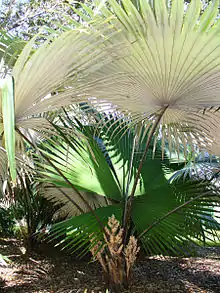Chuniophoeniceae
Chuniophoeniceae is a tribe of palms in subfamily Coryphoideae of plant family Arecaceae. The four genera within the tribe are morphologically dissimilar and do not have overlapping distributions. Three of the genera are monotypic, while the fourth genus (Chuniophoenix) has three species.[1][2]
| Chuniophoeniceae | |
|---|---|
 | |
| Chuniophoenix nana in cultivation at Garfield Park Conservatory | |
| Scientific classification | |
| Kingdom: | Plantae |
| Clade: | Tracheophytes |
| Clade: | Angiosperms |
| Clade: | Monocots |
| Clade: | Commelinids |
| Order: | Arecales |
| Family: | Arecaceae |
| Subfamily: | Coryphoideae |
| Tribe: | Chuniophoeniceae J.Dransf., N.W.Uhl, C. Asmussen, W.J. Baker, M.M. Harley & C.E. Lewis |
| Type genus | |
| Chuniophoenix | |
| Genera | |
|
Chuniophoenix Burret | |
Description
Outwardly, the palms in the four genera of Chuniophoeniceae appear quite different. Chuniophoenix are small palms from the forest understory with clustered stems; Kerriodoxa is a squat, single-stemmed rainforest palm; Nannorrhops is a sprawling desert palm with branching stems; and Tahina is a massive solitary palm from exposed limestone outcrops.[1][3][2][4] They differ significantly in their flowering strategies, too. Chuniophoenix species flower regularly throughout their lives (pleonanthic) and produce hermaphroditic flowers (rarely single gender); Kerriodoxa are also pleonanthic, but are always dioecious; Nannorrhops stems die after flowering (hapaxanthic), though the much-branched plant survives; Tahina produces a massive terminal inflorescence and dies after fruiting. All Chuniophoeniceae have palmate leaves with induplicate folds and tubular bracts partially enclosing the flowers.[1][2][3][4]
Taxonomy
Chuniophoeniceae is one of eight tribes in subfamily Coryphoideae.[5] The tribe is monophyletic and closely related to tribes Caryoteae, Corypheae and Borasseae, forming the syncarpous clade.[1][5][4][6] In a previous classification, prior to the discovery of Tahina, the three other genera were placed in tribe Corypheae, subtribe Coryphinae, together with the genus Corypha.[7] Coincidentally, Corypha and Tahina both share the strategy of producing a massive display of flowers only once before dying.[4]
The four genera have widely disjunct distributions. Chuniophoenix (3 spp.) is found in southern China and Vietnam; Kerriodoxa (1 sp., K. elegans) is restricted to peninsular Thailand; Nannorrhops (1 sp., N. ritchiana) is found in parts of Iran, Afghanistan, Pakistan and the southeastern Arabian Peninsula; while Tahina (1 sp., T. spectabilis) is endemic to a small area of northwestern Madagascar.[1]
Genera
| Image | Genus | Living Species |
|---|---|---|
 | Chuniophoenix Burret, 1937 |
|
 | Kerriodoxa J.Dransf., 1983 |
|
 | Nannorrhops H.Wendl., 1879 |
|
 | Tahina J.Dransf. & Rakotoarinivo, 2008 |
|
Gallery
 Foliage of Chuniophoenix nana
Foliage of Chuniophoenix nana Distinctive white undersides to the leaves of Kerriodoxa elegans
Distinctive white undersides to the leaves of Kerriodoxa elegans.jpg.webp) Fruits of Kerriodoxa elegans
Fruits of Kerriodoxa elegans Silvery-blue foliage of Nannorrhops ritchiana
Silvery-blue foliage of Nannorrhops ritchiana Seedlings of Tahina spectabilis in cultivation
Seedlings of Tahina spectabilis in cultivation
References
- Dransfield, John; Uhl, Natalie W.; Asmussen, Conny B.; Baker, William J.; Harley, Madeline M.; Lewis, Carl E. (2008). Genera Palmarum - The Evolution and Classification of Palms. Royal Botanic Gardens, Kew. ISBN 9781842461822.
- Henderson, Andrew (2015-07-01). "A revision of Chuniophoenix (Arecaceae)". Phytotaxa. 218 (2): 163. doi:10.11646/phytotaxa.218.2.6. ISSN 1179-3163.
- Dransfield, John (1983). "Kerriodoxa, a new coryphoid palm genus from Thailand". Principes. 27: 3–11.
- Dransfield, John; Rakotoarinivo, Mijoro; Baker, William J.; Bayton, Ross P.; Fisher, Jack B.; Horn, James W.; Leroy, Bruno; Metz, Xavier (2008). "A new Coryphoid palm genus from Madagascar". Botanical Journal of the Linnean Society. 156 (1): 79–91. doi:10.1111/j.1095-8339.2007.00742.x. ISSN 0024-4074.
- Dransfield, John (2005). "A new phylogenetic classification of the palm family, Arecaceae". Kew Bulletin. 60: 559–569 – via ResearchGate.
- Bayton, Ross P. (2005). Borassus L. and the borassoid palms: systematics and evolution, PhD thesis. University of Reading.
- Uhl, Natalie W.; Dransfield, John (1987). Genera Palmarum: A Classification of Palms Based on the Work of Harold E. Moore, Jr. L.H. Bailey Hortorium. ISBN 9780935868302.